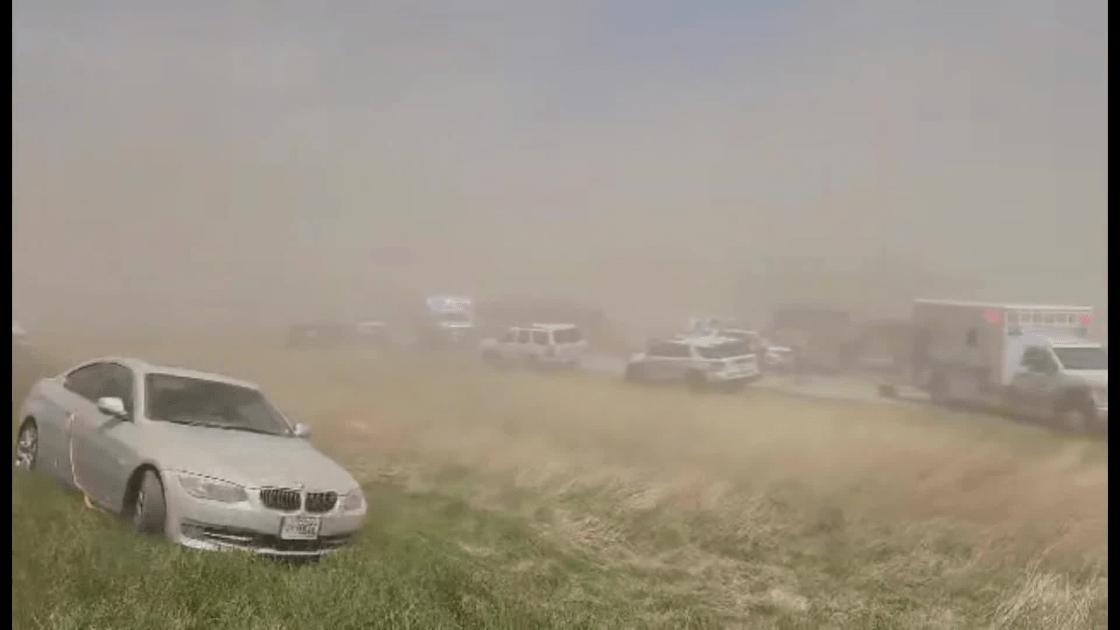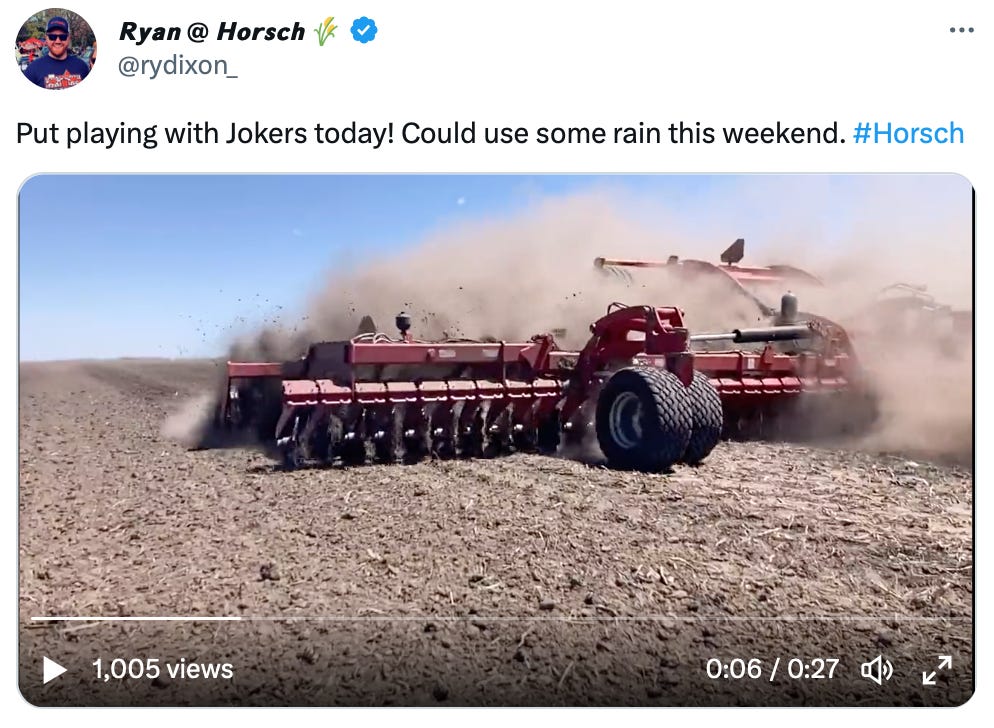Dust to Dust, Crashes to Crashes
Let's just be honest: Corn belt agriculture kills innocent people
As you may have seen on the news, soil blowing from recently-tilled fields caused a tragic and fatal 100 car pile-up on Interstate 55 in Central Illinois. Seven people lost their lives including a 2-year-old toddler.
Scene from Illinois pile up. Image credit: The Hill.
Twitter is a popular place for farmers and the people who derive their income from what farmers do, and the tweet discussion about this event was interesting to observe. The practitioners of agriculture can be almost maniacal at times in their belief about one thing or another when it comes to farming, and this is especially true of tillage, or lack thereof. Many no-tillers risk reduced crop yields and revenue in the first few years following adoption, but once the practice ‘kicks in’ and improved soil biology and reduced fuel costs start to pay dividends, they are born again, and many take to twitter to bear witness on their religion.
The Illinois incident inspired many of the no-tillers to brazenly criticize (there is literally no public criticism of one farmer from another farmer that is not brazen) the steel worshippers for their disregard of the downwind consequences; others on #agtwitter wanted to assign blame for the incident to wind and dry weather and not human decision-making. Never mind that wind and dry weather are among the long list potential possibilities associated with farming in the middle of a continent, where extreme weather is the norm. Meteorologist Bryce Anderson with DTN Progressive Farmer wrote a nice piece describing the human and natural forces causing the event. The National Weather Service said that “The dust originated from freshly tilled and planted farm fields and was kicked up by wind gusts of 35 to 45 mph.” I’ve lived in Iowa most of my life and 35-45 mph winds are not exactly rare. Indeed, Anderson pointed out that similar events happened in Illinois on May 6, 1983; June 3, 1990; and May 17, 2017, and all three of those events caused traffic fatalities. So, this was hardly a one-off event as many in farmer twitter would have you believe.
Ryan Horsch of Illinois was callously happy about his tillage implement a couple of days following the Illinois tragedy.
https://twitter.com/rydixon_/status/1653863453663150082?s=20
.
In my circle, we often wonder why change in agriculture is so maddeningly slow when it comes to agriculture’s environmental outcomes. A common theme in this discussion is there are no ‘bodies on the curb’, i.e., noticeable acute human health effects resulting from crop and livestock production. The Illinois incident, however, was indeed a ‘bodies on the curb’ event, but the idea that the loss of seven lives will catalyze a sea change on tillage practices is absurd.
Other bodies have been lying on the curb a long time.
The Safe Drinking Water Act sets the upper limit for nitrate in drinking water at 10 mg/L (ppm) as nitrogen (nitrate-N). This regulation is designed to be protective of infants, who can suffer from methemoglobinemiawhen exposed to elevated drinking water nitrate. But there is accumulating evidence that nitrate in drinking water is harmful not only to infants, but also adults. A recent (2020) study from Wisconsin shows adult and infant health effects associated with drinking water nitrate: “We estimate that annually, 111–298 combined cases of colorectal, ovarian, thyroid, bladder, and kidney cancer in Wisconsin may be due to nitrate contamination of drinking water. Each year, up to 137–149 cases of very low birth weight, 72–79 cases of very preterm birth, and two cases of neural tube defects could be due to nitrate exposure from drinking water. The direct medical cost estimates for all nitrate-attributable adverse health outcomes range between $23 and $80 million annually.”
Seems likely more than 7 of these cases would result in death, and that’s every year.
Research from Denmark found statistically significant increased risks of colorectal cancer at drinking water levels above 3.87 mg/L nitrate-N. Some people in Iowa never drink water below 3.87 mg/L nitrate-N, unless they travel somewhere on vacation. Some Iowans drinking water from their own wells or from public water supplies can drink water over 5 mg/L nitrate-N for months or even years on end. Almost 7000 private wells in Iowa have been contaminated with nitrate-N above 10 mg/L since 2000.
We’ve known for almost two decades that proximity to confined animal feeding operations (CAFOs) is linked to childhood asthma. Depending on how you define CAFO, we have between 3000 and 8000 of them in Iowa (the latter number is how many required construction permits from Iowa DNR). The linked study found Iowa school children “in the study school had a significantly increased prevalence of physician-diagnosed asthma (adjusted odds ratio, 5.71; p = 0.004). Although this group was more likely to live on a farm and have parents who smoke, these potentially confounding variables did not account for increased prevalence in a multivariate model.” A 2002 study conducted by Iowa State University and the University of Iowa found “extensive literature documenting acute and chronic respiratory diseases and dysfunction among workers, especially swine and poultry workers, from exposures to complex mixtures of particulates, gases and vapors within CAFO units.”
Our 25 million hogs and 80 million laying chickens couldn’t live in these densely populated conditions without the disease protection of antibiotics. And guess what—this breeds resistance to the antibiotics. People living within one mile of an Iowa CAFO have been found to carry methicillin-resistant Staphylococcus aureus (MRSA) in their nostrils at a rate three times that of the rest of us. Workers in swine barns are six times more likely to carry multi-drug resistant Staphylococcus aureus (MDRSA).
And with manure odors regularly wafting into the middle of our biggest urban areas, it stands to reason that just about every Iowan is breathing in farm chemicals during the course of their lives. This includes the Roundup replacement Dicamba, known to volatilize and travel long distances when applied in hot weather.
So bear in mind that we have known all this stuff for years, decades in some cases. So, seven deaths caused by tillage? Tragic, to be sure. But let’s be mindful of the big picture.
As far as (no)till, I don’t farm and I don’t endorse anything because I have better things to do than fight off whatabouters, and believe me, whataboutism is about as common in Iowa farming as white skin. I do tend to admire anybody trying to do something different that will contribute to the common good. But no one should consider no-till as being without its own set of environmental consequences—more chemical and more drainage tile being two. Remember—tillage does suppress weeds. And some types of tillage (implement, timing, etc.) are clearly worse than others. In a sense, both tillage and chemical are one in the same—inputs of ENERGY to achieve the objective of weed suppression (tillage is also done for many other reasons which I won’t get into here).
So long and short, I would caution the no-tillers from getting too self-righteous about the seven Illinois deaths. Swearing off the steel may keep a few more 2-year-olds from dying in 100-car pileups, but what’s needed here is a reckoning of the human and ecological costs associated with the entire system of crop and livestock production.
About my book: The Swine Republic is a collection of essays about the intersection of Iowa politics, agriculture and environment, and the struggle for truth about Iowa’s water quality. Longer chapters that examine ‘how we got here’ and ‘the path forward’ bookend the essays. Foreword was beautifully written by Tom Philpott, author of Perilous Bounty. Choice of free book copy or t-shirt for all paid subscribers to this Substack ($30 value).








Thanks again and again Chris. You have been a patient critic since you cared for our water supply at the Des Moines Waterworks until now. I am so pleased that you have not given up on us. Most Iowans care deeply about our children, their future and the future of this blessed state. Greed in not good. Adam Smith did not say it was--though some spin his work that way. Greed is sinful. Our moral leaders must stand up even though many church members are part of the problem. Thanks to Plymouth Church in Des Moines for given truth-tellers a forum recently. Mike Delaney
Agree that this was a human-derived crash. Nothing will change until we change